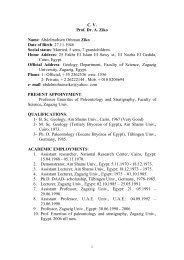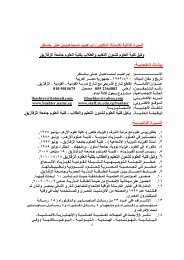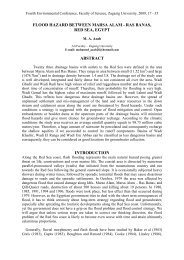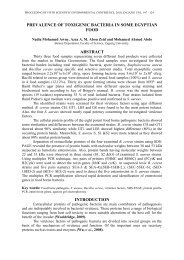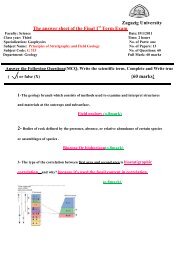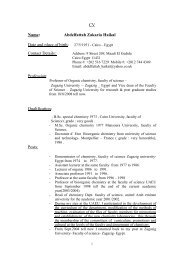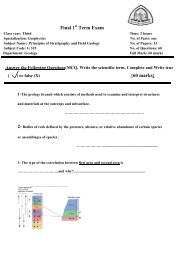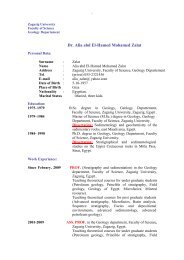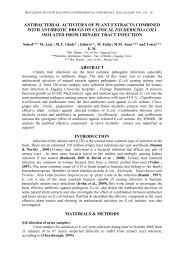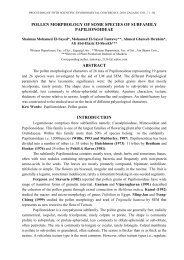58 Seismic study to recognize reef reservoirspatterns, which include amplitude, frequency and continuity changes(seismic facies change).Among the seismic criteria as represented on Figs. (7) and (8), that areused in the present study to recognize the carbonate build-ups on theavailable seismic sections are:..a) Outline reflection:The reflection from the top and side boundaries of the build-ups andits shape, which is generally mound-like, is a good criterion to recognizereefs (build-ups). This criterion results from the acoustic impedancecontrast between reefs and the overlying strata.b) Seismic facies change:The seismic facies change between the reefs and the enveloping strataincludes amplitude, frequency and continuity changes. It results from themain difference in the petrographic properties between the reefs and theadjacent strata, which leads to the comparable difference in reflectionconfiguration patterns between the reefs and the adjacent strata.c) Drape in the overlying strata:The reefs are physically less compacted than the normally adjacentstrata, which may be evaporites or intercalations of carbonates andanhydrite. This criterion appears on the seismic sections as drape in theoverlying strata to reefs and this drape decreases up-ward.d) Velocity anomaly:The reefs are characterized by their higher velocities than thevelocities of the adjacent strata which are a lot of higher. This criterionappears on the seismic sections as pulled-up of the underlying strata toreefs. In some cases, if the velocity of the reefs is lower than the velocityof the adjacent strata (may be due to the effect of fluids content withinthe reefs) and in this case the reflections of the underlying strata to reefsare pulled-down.3- Environment, mapping and distribution of reefs:Depositional environments can be predicted from seismic reflectiondata through the interpretation of seismic reflection. Reflectionamplitude contains information of the velocity density contrast,individual interfaces, and on the extent of inter-bedding. Continuity ofreflectors is closely associated with the continuity of bedding. The
Ghalib M. et. al. 59sediments deposited in shelf environment tend to generate parallel togently divergent reflection configurations having a widespread sheet orwedge-shaped external form (Sangree and Widmier, 1979).Depositional environment of Nullipore rock:On the available interpreted seismic grid, the reflection patterns, ofHammam Faraun seismic sequence (Nullipore rock), are of greatcontinuity and high amplitude in the main parts of the sequence. Bycompare the external form of the Hammam Faraun seismic sequence onthe dip lines: Line-I, Line-2, Line-3, Line-4, Line-5 and Line-6, asshown on the shoot points and well location map, Fig. (3), with theexternal form to it on the strike lines: Line-9, Line-IO and Line-I I, we, can conclude that, the external form of the Hammam Faraun sequence issheet- like to wedge-shape. These two parameters of high continuity andhigh amplitude of reflection patterns, and the sheet-like external formreflect that, the Hammam Faraun Member is deposited in shelfenvironment (shallow marine environment), which is suitable tocarbonate build-ups.On little parts of the Hammam Faraun sequence, the reflectionpatterns change from high continuity and high amplitude parallelpatterns to chaotic and reflection free to amplitude anomaly patterns.These patterns (chaotic and reflection free to amplitude anomaly) revealthat, the energy is high in these parts of the sequence than the main parts(which represent parallel patterns with high continuity and highamplitude). These conditions are suitable to reefs growth. The seismicfacies units on the sequence of Hammam Faraun, which representchaotic and reflection free to amplitude anomaly reveal the presence ofreefs in these parts of the sequence.Interpretation of reflection configuration:Seismic reflection termination and configurations are interpreted asstratification patterns and are used for the recognition and correlation ofdepositional sequences, interpretation of depositional environment, andestimation of litho-facies (Mitchum et ai, 1977- part 6). Seismic faciesunits are mappable, three dimensional seismic units are composed of agroup of seismic reflections, whose parameters (configuration,amplitude, continuity, frequency, and interval velocity) differ from the
- Page 1 and 2:
GEOPHYSICS LETTERS
- Page 3 and 4:
GEOPHYSICS LETTERSREVIEWERSProf. Dr
- Page 5 and 6:
Geophys. Lett., 1 (2008)1-20DELINEA
- Page 7 and 8:
Abeer Abd El-Rehim El-Kenawy 3with
- Page 9 and 10:
A beer Abd El-Reltim El-Kenawy 5inv
- Page 11 and 12: A beer Abd EI-Rehim El-Kenawy 7sour
- Page 13 and 14: A beer Abd El-Rehim El-Kenawy 9Figu
- Page 15 and 16: Abeer Abd El-Rehim El-Kenawy 113113
- Page 17 and 18: Abeer Abd EI-RehimEI-Kenawy13~m,,~3
- Page 19 and 20: Abeer Abd El-Rehim El-Kenawy 153113
- Page 21 and 22: Abeer Abd El-Rehim El-Kenawy 17..I:
- Page 23 and 24: Abeer Abd El-Rehim El-Kenawy 19Klin
- Page 25 and 26: Geophys. Lett., 1 (2008) 21-;53PETR
- Page 27 and 28: Ghalib, M. et. aL 232-Related the r
- Page 29 and 30: Ghalib, M. et. al. 25vuggy porosity
- Page 31 and 32: Ghalib, M. et. al. 27This zone is t
- Page 33 and 34: Ghalib, M. et. aL 29The third elect
- Page 35 and 36: Ghalib, M. et. aL 31The bulk volume
- Page 37 and 38: Ghalib, M. et. al. 33occurrence of
- Page 39 and 40: Ghalib, M. et. al.35!AGEI:::",1\I!O
- Page 41 and 42: Ghalib, M. et. aL 37Southi Rock:Ham
- Page 43 and 44: Ghalih, M. et. aL 39,I SouthRock un
- Page 45 and 46: Ghalib, M. et. aL 41--;;>s:Rock uni
- Page 47 and 48: , 0°"IIIC.y.,,~umGhalib, M. et. aL
- Page 49 and 50: Ghalib, M. et. al. 45E!i-'(jjs::CII
- Page 51 and 52: Ghalib, M. et. al. 47CALsJ!!L 16BS(
- Page 53 and 54: Ghalih, M. et. al.49"LLO@I\SCILLoad
- Page 55 and 56: Ghalib, M. et aL 51REFERENCESAsquit
- Page 57 and 58: Geophys. Lett., 1 (2008) 53 .80SEIS
- Page 59 and 60: Ghalib M. et. aL 55of the gulf itse
- Page 61: Ghalib M. et. aL 572- Interpretatio
- Page 65 and 66: Ghalib M. et al. 61Faraun seismic s
- Page 67 and 68: Ghalib M. et. al. 63the seismicrefl
- Page 69 and 70: Ghalib M. et. aL 65C'Il.-NC'II.-;j>
- Page 71 and 72: Ghalib M. et al.67.:::Q.,,", .a)1"0
- Page 73 and 74: Ghalib M. et. aL 69-~Q ~-=~.l::....
- Page 75 and 76: ,:..'Ghalib M. et.aL 71~ t()~=M.~ ~
- Page 77 and 78: Ghalib M. et. aL 73(IJ0! 0I!!.e-a,'
- Page 79 and 80: Ghalib M. et. aL 75816Cl>...N+-z818
- Page 81 and 82: '" ...Ghalib M. et. al. 77"-"'...,-
- Page 83 and 84: Ghalib M. et. al. 79of the American



